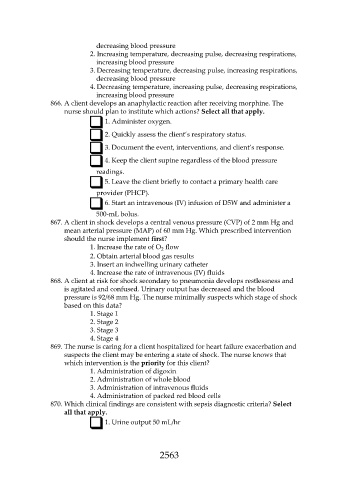Page 2563 - Saunders Comprehensive Review For NCLEX-RN
P. 2563
decreasing blood pressure
2. Increasing temperature, decreasing pulse, decreasing respirations,
increasing blood pressure
3. Decreasing temperature, decreasing pulse, increasing respirations,
decreasing blood pressure
4. Decreasing temperature, increasing pulse, decreasing respirations,
increasing blood pressure
866. A client develops an anaphylactic reaction after receiving morphine. The
nurse should plan to institute which actions? Select all that apply.
1. Administer oxygen.
2. Quickly assess the client’s respiratory status.
3. Document the event, interventions, and client’s response.
4. Keep the client supine regardless of the blood pressure
readings.
5. Leave the client briefly to contact a primary health care
provider (PHCP).
6. Start an intravenous (IV) infusion of D5W and administer a
500-mL bolus.
867. A client in shock develops a central venous pressure (CVP) of 2 mm Hg and
mean arterial pressure (MAP) of 60 mm Hg. Which prescribed intervention
should the nurse implement first?
1. Increase the rate of O flow
2
2. Obtain arterial blood gas results
3. Insert an indwelling urinary catheter
4. Increase the rate of intravenous (IV) fluids
868. A client at risk for shock secondary to pneumonia develops restlessness and
is agitated and confused. Urinary output has decreased and the blood
pressure is 92/68 mm Hg. The nurse minimally suspects which stage of shock
based on this data?
1. Stage 1
2. Stage 2
3. Stage 3
4. Stage 4
869. The nurse is caring for a client hospitalized for heart failure exacerbation and
suspects the client may be entering a state of shock. The nurse knows that
which intervention is the priority for this client?
1. Administration of digoxin
2. Administration of whole blood
3. Administration of intravenous fluids
4. Administration of packed red blood cells
870. Which clinical findings are consistent with sepsis diagnostic criteria? Select
all that apply.
1. Urine output 50 mL/hr
2563

